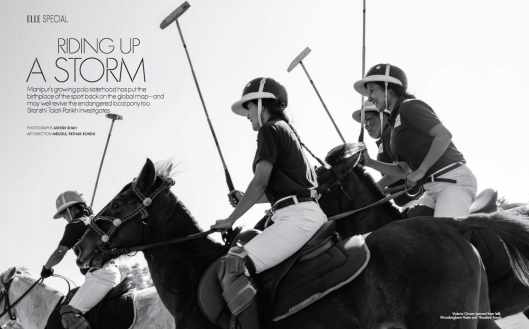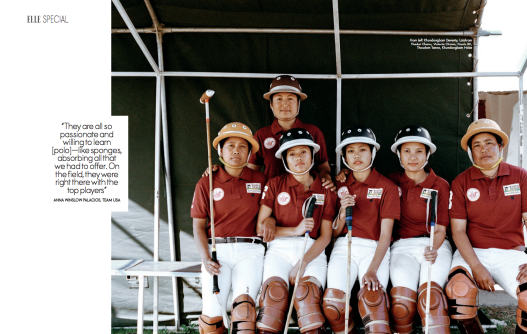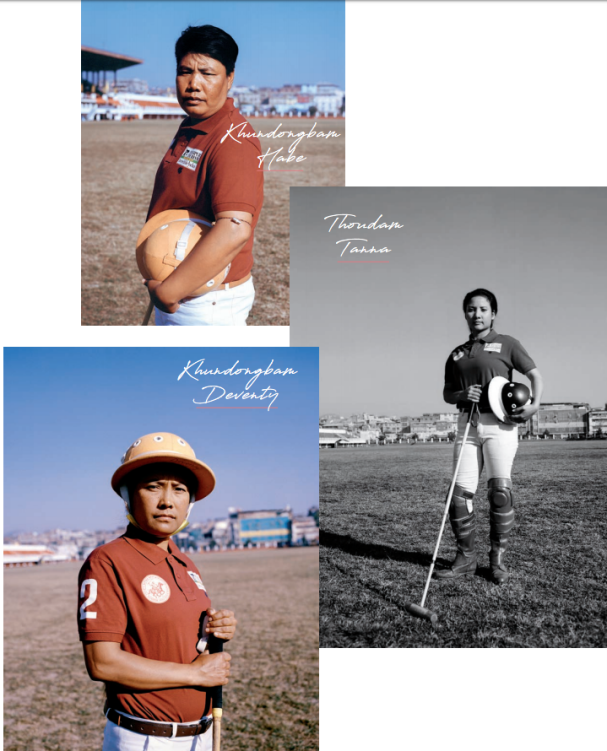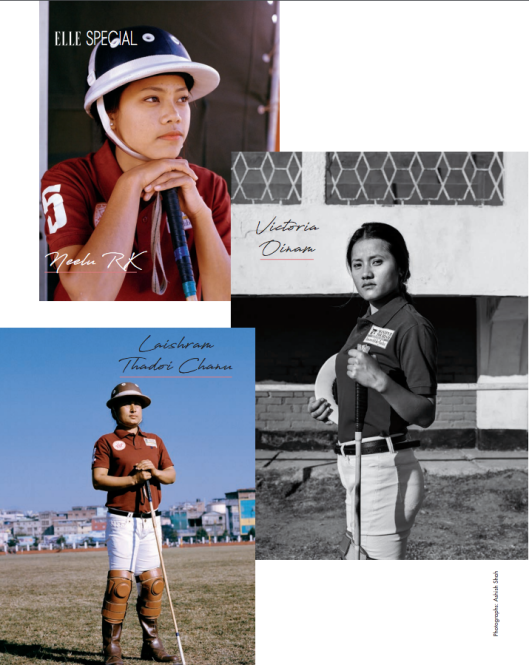Tags
Daughters of the Polo God, Elle India, Manipur, Manipuri Pony, Polo, Roopa Barua, Somi Roy, Women's Polo
Published: Elle Magazine, March 2019
Photographs: Ashish Shah
Manipur’s growing polo sisterhood has put the birthplace of the sport back on the global map—and may well revive the endangered local pony too….

On a hill around Heingang village, on the outskirts of Imphal, there is a pony shrine to Lord Marjing, the god of polo, where the Meitei (the majority ethnic group of Manipur) come to worship, and where the local polo players go to light candles before a game. There is mystical energy at the shrine as prayers are offered to Sanamahi, the patron god of every Meitei household, who created the Samadon Ayangba—a fast and fierce pony with wings.
The legendary Manipuri Pony is symbolic of a culture that has struggled in many ways to ride forward. L Somi Roy, the grandson of Manipur’s former monarch Maharaja Churachandra, left Manipur for USA in the ’80s and on his return two decades later, found the pony listlessly ambling the streets of Imphal feeding on plastic. Despite its mythological and historical importance, the semi-feral animal’s grazing areas were lost due to negligent urbanisation. Today, the Manipuri Pony is an endangered species with an estimated population of fewer than 500.
Roy, who is a conservationist and a custodian of culture, realised that the only way to keep the pony alive would be to help build up Sagol Kangjei (Manipuri polo) by bringing international attention to it. Manipur is considered the birthplace of modern polo—the British later exported the sport to the rest of the world. Mapal Kangjeibung polo ground, situated in the heart of Imphal and surrounded by urban buildings, is one of the oldest extant grounds in the world. It dates to the early 17th century, with references that go back to the first century AD during the reign of King Kangba.
As polo has been male-dominated in Manipur, female players were seriously lagging in the sport due to lack of opportunity and direction. That changed with Roy’s initiatives. Drawing upon his contacts at the United States Polo Association (USPA) in 2013, Roy, along with his US partner Ed Armstrong, began inviting women’s polo teams from abroad to hold a local tournament in Imphal.

And thus began the Manipur Statehood Day Women’s Polo Tournament, India’s only international women’s polo tournament, in 2016, in partnership with Roy’s Polo Yatra (an enterprise for women’s polo in India), the USPA, and Manipur Tourism, with only one visiting team: USA. The annual tournament has grown exponentially since then. The recently-concluded season in January this year had four foreign teams—USA, Canada, Kenya and Argentina—along with the Indian Polo Association (IPA) team with the support of Manipur Tourism, Incredible India, and the Bombay Stock Exchange. It was produced by Polo Yatra and organised by the All Manipur Polo Association. In testimony to its growing global standing, Argentina put together a tournament called the Manipur Cup in 2018, where the winners of the 13 participating teams came to play in Manipur.
Daughters Of The Polo God (2018), an award-winning documentary film on the female polo players of Manipur, which had its India premiere on the opening night of the tournament, perfectly captures the spirit on the ground. Roopa Barua, the film’s director, says, “I had only heard stories of civil unrest, terrorists and army atrocities in Manipur. But when I went to Imphal for the tournament in 2016, I saw that women’s polo was a growing story—the symbiotic relationship between women’s polo and the endangered Manipuri Pony was a very unique concept.”
Roy points out, “Women have been at the forefront of change in Manipur—they are entirely fearless.” Three-fourths of the country’s female polo players come from the state. It has 26 polo clubs, many of which have women players (two of these clubs are even owned by women), with over 30 women players and five women’s teams in Imphal alone. Fifty-four-year-old Thoudam Thoinu Devi exemplifies the term “boss lady”: she owns the Chingkhei Humba Polo Club, which now has over 80 horses that belong to its members. Her niece, 23-year-old Thoudam Tanna, who was named Best Manipuri Player in this tournament, is as formidable on the field as her aunt is off it. “She was nobody in that world—less than 15 years old, she came in her old clothes—and yet she won first prize at the equestrian games,” says a proud Thoinu about her niece in Daughters….

The local polo players hail from humble backgrounds—in Manipur, polo isn’t linked to economic status and the players don’t necessarily own their horses. Khundongbam Habe, at 35, the oldest local player this season, sells vegetables to pay the bills. “Maintaining ponies is very difficult and expensive. The polo association contributes to their care, but there are hurdles, like the lack of grazing grounds and the decreasing number of ponies,” she says. An untrained pony could cost INR 50,000, while trained animals could range from anywhere between one lakh and three lakh rupees. And then there is the burden of gender inequality—the players describe how the men’s teams have many more facilities and are also sent for equestrian jumping and national games, while the women’s teams are not.
On January 17, at the opening ceremony of the polo tournament, 18 local and international artistes performed with a range of instruments including the Manipuri pena and the guitar in sweet synergy. It is symbolic of the camaraderie displayed by the local and international teams on and off the ground. Anna Winslow Palacios, from Team USA, who was in Manipur for the second time, was impressed with the improvement in the play of the local girls—they drew with Kenya and lost to Argentina by just two goals. At the insistence of Ricardo Mihanovich of the Federation Of International Polo and Ed Armstrong of Team USA, they received the first Most Improved Team award from Polo Yatra. Palacios says, “They are all so passionate and willing to learn—like sponges, absorbing all that we had to offer. On the field, they were right there with the top players.”
The Manipuri women players are self-trained—they don’t abide strictly by fixed international or Indian rules of polo. And the Manipuri Pony, unlike a thoroughbred, is no longer ideal for modern polo—it is small, even if it is swift and lithe. Delhi-based Monica Saxena, the captain of the IPA, says, “The horse is 80 per cent of the game. The challenge is that the Manipuri girls only learn and play on the local horses, but I see great potential in them. With proper coaching, they can beat any international team.”
Some of the foreign players take time off before the matches to teach the Manipuri players, often with the help of translators, as not all the local players speak English. And as recently as November 2018, The Tata Trust company, at Roy’s initiative, formed a centre in Imphal where 20 local players were inducted to undergo training. Mriganka Singh, from team IPA, says, “I have lived and played in Delhi, where there are very few women polo players and no tournaments like this that allow you to improve your game. Polo in Delhi is very competitive; my polo experience in Manipur with players of all ages, from 14- to 50-years-old—was unique and a reminder of the reason for my passion for the sport.”
Perhaps coming full circle the foot of the shrine to Lord Marjing is a 200-acre piece of land sanctioned for a pony preserve. “While saving the pony is an ongoing struggle, we have a policy in place, and it is declared an endangered breed,” says Roy. During the tournament, there was a pony preservation conference held at Manipur University, where the participation of players from the international teams further underscored the global concern for this breed’s conservation.

Meanwhile, fresh out of the tournament where their team gave their more-experienced opponents a run for their money, Tanna and 20-year-old Victoria Oinam and Neelu RK are on a high that their eventual loss hasn’t dampened. Says Tanna’s sister, Thoudam Sanajaobi, also a state polo player, as she sits out and cheers herself hoarse while her sister plays this season, “I dream of going to other places to play polo.” They turn to look at the foreign players, with wistfulness and the uncynical hope of youth, awaiting a time when they may celebrate the Manipuri Pony and its sporting tradition by riding beyond borders.


 Shoes by You Khanga.
Shoes by You Khanga.  Vintage agate and diamond earrings designed by her father Dinesh Jhaveri in the 1970s.
Vintage agate and diamond earrings designed by her father Dinesh Jhaveri in the 1970s.


 Colour-coordinated brocade saris.
Colour-coordinated brocade saris. Distressed jeans from Hong Kong.
Distressed jeans from Hong Kong.
 A pair of indigo brogues from Miz Mooz, New York
A pair of indigo brogues from Miz Mooz, New York Reversible handwoven jacket from Payal Khandwala.
Reversible handwoven jacket from Payal Khandwala.



















